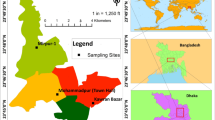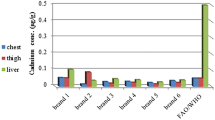Abstract
Braised and flamed chickens known as “poulet bicyclette” are famous and popular street food in Burkina Faso. Although they are important sources of a wide range of essential trace elements for humans, they can also contain toxic metals. The aim of the study was to assess the concentrations and health risk of metallic trace elements (Ag, Cr, Cu, Mn, Fe, Co, Zn, Ni, Cd, Pb) in ready-to-eat braised and flamed chickens in Burkina Faso. The concentrations and health risk assessment were estimated by atomic absorption spectrometry and hazard quotient method, respectively. The concentrations of Cu (3.12 mg kg−1), Fe (20.17 mg kg−1), and Ni (0.22 mg kg−1) were about 2 times higher in flamed chickens than in braised ones. Cd (0.45 mg kg−1) and Cr (2.50 mg kg−1) were 2 to 5 times more concentrated in braised chickens than flamed chickens. Pb was found in 72.72% of braised chicken and 62.06% of flamed chicken samples, above the maximum limit set by the JECFA. The daily intakes of Cu, Mn, Fe, and Zn contributed for less than 2% to the recommended daily intakes set by the Institute of Medicine of USA for both males and females, whereas Cr contributed for more than 20% from braised chicken. The estimated monthly intakes of Cd represented about 1.92–4.06% of the provisional tolerable monthly intake of Cd set by FAO/WHO. A non-cancer risk estimated as hazard index has been recorded at the maximum level of consumption for female consumer group for flamed chicken (HI = 2.14). The estimated cancer index risk in this study is below the reference value (10−4) set by the United States Environmental Protection Agency (US EPA).


Similar content being viewed by others
Data Availability
Samples of the processed chickens at University Joseph KI-ZERBO of Ouagadougou.
References
FAO (Food and Agriculture Organization) (2018) Food Outlook, Biannual Report on Global Food. Maket, Rome
Ferguson LR (2010) Meat and cancer. Meat Sci 84:308–313. https://doi.org/10.1016/j.meatsci.2009.06.032
MRAH (Ministere des ressources Animales et Heleutiques) (2014) Annuaire des Statistiques de l’Élevage 2012, Burkina Faso
Wada O (2004) What are trace elements? Their deficiency and excess states. Jpn Med Assoc J 47:351–358
WHO (1996) Trace elements in human nutrition and health. Joint WHO/FAO/IAEA Expert Consultation, Geneva
USEPA (United States Environmental Protection) (2007) framework for metals risk assessment, EPA 120/R-07/00. Office of the Science Advisor, Washington DC
Chang L, Magos L, Suzuki T (1996) Toxicology of metals, CIS/96/022. CRC Press, Boca Raton
Ambushe AA, Hlongwane MM, Mccrindle RI, Mccrindle CME (2012) Assessment of levels of V , Cr , Mn , Sr , Cd , Pb and U in bovine meat. S Afr J Chem:159–164
Bamuwamye M, Ogwok P, Tumuhairwe V (2015) Cancer and non-cancer risks associated with heavy metal exposures from street foods: evaluation of roasted meats in an urban setting. J Environ Pollut Hum Health 3:24–30. https://doi.org/10.12691/jephh-3-2-1
Gemma Perell O, Roser Mart I, Cid JML, Domingo JEL (2008) Effects of various cooking processes on the concentrations of arsenic, cadmium, mercury, and lead in foods. J Agric Food Chem 56:11262–11269. https://doi.org/10.1021/jf802411q
Mansour S, Belal M, Abou-Arab AA, Gad M (2009) Monitoring of pesticides and heavy metals in cucumber fruits produced from different farming systems. Chemosphere 75:601–609. https://doi.org/10.1016/j.chemosphere.2009.01.058
Demirel S, Tuzen M, Saracoglu S, Soylak M (2008) Evaluation of various digestion procedures for trace element contents of some food materials. J Hazard Mater 152:1020–1026. https://doi.org/10.1016/j.jhazmat.2007.07.077
Akinyele IO, Shokunbi OS (2014) Comparative analysis of dry ashing and wet digestion methods for the determination of trace and heavy metals in food samples. Food Chem 173:682–684. https://doi.org/10.1016/j.foodchem.2014.10.097
Koubová E, Sumczynski D, Šenkárová L, Orsavová JFM (2018) Dietary intakes of minerals, essential and toxic trace elements for adults from Eragrostis tef L.: A Nutritional Assessment. Nutrients 10:1–11. https://doi.org/10.3390/nu10040479
IOM (Institute of Medicine) (1997) Dietary reference intakes for calcium, phosphorus, magnesium, vitamin d, and fluoride. National Academies Press, Washington, DC
IOM (Institute of Medicine) (2000) Dietary reference intakes for vitamin C, vitamin E, selenium, and carotenoids. National Academies Press, Washington, DC
IOM (Institute of Medicine) (2001) Dietary reference intakes for vitamin a, vitamin k, arsenic, boron, chromium, copper, iodine, iron, manganese, molybdenum, nickel, silicon, vanadium, and zinc. National Academies Press, Washington, DC
Peycheva K, Panayotova V, Stancheva M (2016) Assessment of human health risk for copper, arsenic, zinc, nickel, and mercury in marine fish species collected from Bulgarian black sea coast. Int J Fish Aquat Stud 4:41–46
Liu X, Song Q, Tang Y et al (2013) Human health risk assessment of heavy metals in soil-vegetable system: a multi-medium analysis. Sci Total Environ 463–464:530–540. https://doi.org/10.1016/j.scitotenv.2013.06.064
Duan B, Zhang W, Zheng H et al (2017) Comparison of health risk assessments of heavy metals and as in sewage sludge from wastewater treatment plants ( WWTPs ) for adults and children in the urban district of Taiyuan, China. Int J Environ Res Public Health 14:1194. https://doi.org/10.3390/ijerph14101194
USEPA (United States Environmental Protection) (1989) Risk assessment guidance for superfund. Human Health Evaluation Manual, (Part A). USEPSA, Washington, DC
Ministère de la Santé BF (2014) Rapport de l’enquête nationale sur la prévalence des principaux facteurs de risques communs aux maladies non transmissibles au Burkina Faso. Enquete steps 2013, Ministère de la Santé, Ouagadougou
OEHHA (Office of Environmental Health Assessment) (2005) Air toxics hot spots program risk assessment guidelines: part II technical support document for describing available cancer potency factors, Oakland (CA)
Cao SZ, Duan XL, Zhao XG et al (2014) Health risks from the exposure of children to As, Se, Pb and other heavy metals near the largest coking plant in China. Sci Total Environ 472:1001–1009. https://doi.org/10.1016/j.scitotenv.2013.11.124
Joint FAO/WHO Food Standards Programme Codex Committee on Contaminants in Foods (2011) Working document for information and use in discussions related to contaminants and toxins in the GSCTFF. Fifth session. FAO/WHO, The Hague
Dinesh M, Bechan S, Chitranjan K, Shiv B (2012) Cadmium and lead bioaccumulation during growth stages alters sugar and vitamin c content in dietary vegetables. Proc Natl Acad Sci India Sect B Biol Sci 82:477–488. https://doi.org/10.1007/s40011-012-0057-6
Loredo J, Ordonez A, Charlesworth S, De-Miguel E (2003) Influence of industry on the geochemical urban environment of Mieres (Spain) and associated heath risk. Environ Geochem Health 25:307–323. https://doi.org/10.1023/A:1024521510658
Manasreh WA (2010) Assessment of trace metals in street dust of Mutah city, Kurak, Jordan, Carpath. J Earth Environ 5:5–12
Saeedi M, Li LY, Salmanzadeh M (2012) Heavy metals and polycyclic aromatic hydrocarbons: pollution and ecological risk assessment in street dust of Tehran. J Hazard Mater 227–228:9–17. https://doi.org/10.1016/j.jhazmat.2012.04.047
Koubová E, Daniela Sumczynski D, Lenka Šenkárová L et al (2018) Dietary intakes of minerals, essential and toxic trace a nutritional assessment. Nutrients 10:1–11. https://doi.org/10.3390/nu10040479
FAO/WHO (2011) Evaluation of certain food additives and contaminants: seventy-third report of the joint FAO/WHO expert committee on food additives. WHO Press, Geneva
WHO (2005) Nickel in drinking-water: in background document for development of who guidelines for drinking-water quality. WHO Press, Geneva
Acknowledgments
Special thanks go to the anonymous reviewers and editors for their contributions in improving the manuscript.
Funding
This study is funded by the Académie de Recherche et d’ Enseignement Supérieur (ARES), Belgique under The QualiSani project. The funder had no role in the study design, data collection, analysis, interpretation of data, and writing of the manuscript.
Author information
Authors and Affiliations
Contributions
BSRB, AB, AS, JTO, EK, DJH, MLS, AS, and IHNB conceived and designed the experiment study. BSRB, AB, AS, JTO, AS, and IHNB performed the study. BSRB, AB, AS, JTO, EK, DJH, MLS, AS, and IHNB wrote the paper.
Corresponding author
Ethics declarations
Conflict of Interest
The authors declare that they have no conflict of interest.
Ethical Approval
The design and conduct of the survey were approved by the Institutional Review Board of the University Joseph KI-ZERBO of Ouagadougou.
Consent to Participate
Informed consents from participants were obtained prior to interview.
Additional information
Publisher’s Note
Springer Nature remains neutral with regard to jurisdictional claims in published maps and institutional affiliations.
Rights and permissions
About this article
Cite this article
Bazié, B.S.R., Bougma, A., Séré, A. et al. Concentrations and Health Risk Assessment of Metallic Trace Elements in Ready-to-Eat Braised and Flamed Chickens in Burkina Faso. Biol Trace Elem Res 199, 1556–1565 (2021). https://doi.org/10.1007/s12011-020-02252-2
Received:
Accepted:
Published:
Issue Date:
DOI: https://doi.org/10.1007/s12011-020-02252-2




